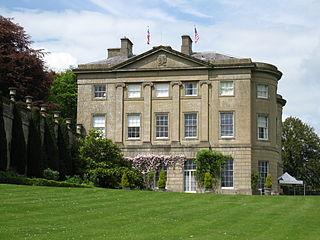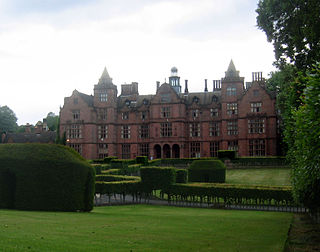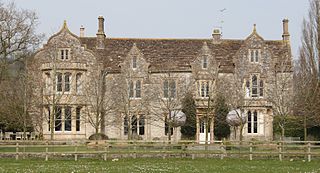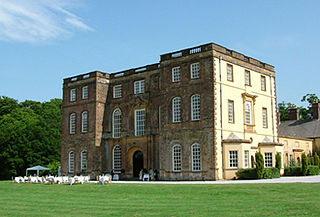
The American Museum and Gardens is a museum of American art and culture based at Claverton, near Bath, England. Its collections of American furniture, quilts and folk art are displayed in a Grade I listed 19th-century house, surrounded by gardens overlooking the valley of the River Avon.

Dulverton is a town and civil parish in west Somerset, England, near the border with Devon. The town had a population of 1,408 at the 2011 Census. The parish includes the hamlets of Battleton and Ashwick which is located approximately 4 miles (6.4 km) north west of Dulverton.

Broadlands is a country house located in the civil parish of Romsey Extra, near the town of Romsey in the Test Valley district of Hampshire, England. Its formal gardens and historic landscape are Grade II* listed on the Register of Historic Parks and Gardens. The house itself is Grade I listed.

Hewell Grange is a former country house in Tardebigge, Worcestershire, England. "One of the most important late 19th century country houses in England", the mansion was built between 1884 and 1891 by George Frederick Bodley and Thomas Garner for Robert Windsor-Clive, later first Earl of Plymouth. Constructed in the Jacobethan style, it was "perhaps the last Victorian prodigy house". After the Second World War, the third earl sold the Hewell estate to the Crown and it was redeveloped as a prison. The mansion was used to house young offenders, and later low-risk prisoners, while adult prisons were built in the grounds. The site was subsequently consolidated as HM Prison Hewell. In 2019, the Ministry of Justice announced the closure of the Category D open prison housed in Hewell Grange, after a highly critical report by Her Majesty's Inspectorate of Prisons.

Cricket St Thomas is a parish in Somerset, England, situated in a valley between Chard and Crewkerne and was formerly within the South Somerset administrative district. The A30 road passes nearby. The parish has a population of 50. It is noted for the historic manor house known as Cricket House, and its estate in recent times formerly home to a wildlife park.

Dunham Massey is a civil parish in the Metropolitan Borough of Trafford, Greater Manchester, England. The parish includes the villages of Sinderland Green, Dunham Woodhouses and Dunham Town, along with Dunham Massey Hall and Park, formerly the home of the last Earl of Stamford and owned by the National Trust since 1976. Dunham Massey is in the historic county of Cheshire, but since 1974 has been part of Trafford Metropolitan Borough; the nearest town is Altrincham. At the 2001 census, the parish had a population of 475.

St Cuthbert Out, sometimes Wells St Cuthbert Out, is a civil parish in the Mendip district of Somerset, England. It entirely surrounds the city and parish of Wells. According to the 2011 census it had a population of 3,749.

Tracy Park is an estate near Wick, South Gloucestershire, close to the boundary with Bath and North East Somerset and approximately 5 miles (8.0 km) from the World Heritage City of Bath. Set in approximately 240 acres (97 ha) of parkland, the house is a Grade II listed building. It has a 17th-century nucleus behind a classical two-storey front built of Ashlar stone. The gate piers either side of the carriageway leading to the house are also Grade II listed.

Dinder is a small village and former civil parish, now in the parish of St Cuthbert Out, in the Somerset district, in the ceremonial county of Somerset. It is 2+1⁄2 miles west of Shepton Mallet, and 2 miles east of Wells. In 1961 the parish had a population of 198.

The Abbey, Ditcheat is a large house at Ditcheat in Somerset. Originally a rectory, now converted into a house, the Grade II* listed building dates from the 15th century. To the rear of the Abbey is a Grade II listed granary.

Ditcheat is a village and civil parish 4.5 miles (7 km) south of Shepton Mallet, and 2.5 miles (4 km) north-west of Castle Cary, in Somerset, England. Besides the village, the parish has four hamlets: Wraxall, Lower Wraxall, Alhampton and Sutton.

Halswell House is a Grade I listed country house in Goathurst, Somerset, England.

Adlington Hall is a country house near Adlington, Cheshire. The oldest part of the existing building, the Great Hall, was constructed between 1480 and 1505; the east wing was added in 1581. The Legh family has lived in the hall and in previous buildings on the same site since the early 14th century. After the house was occupied by Parliamentary forces during the Civil War, changes were made to the north wing, including encasing the Great Hall in brick, inserting windows, and installing an organ in the Great Hall. In the 18th century the house was inherited by Charles Legh who organised a series of major changes. These included building a new west wing, which incorporated a ballroom, and a south wing with a large portico. It is possible that Charles Legh himself was the architect for these additions. He also played a large part in planning and designing the gardens, woodland and parkland, which included a number of buildings of various types, including a bridge known as the Chinese Bridge that carried a summerhouse.
Bolesworth Castle is a country house 2 miles (3 km) south of the village of Tattenhall, Cheshire, England. It is recorded in the National Heritage List for England as a designated Grade II* listed building.

Pitcombe is a village and civil parish 1 mile (2 km) south-west of Bruton and 5 miles (8 km) from Wincanton in Somerset, England. It has a population of 532. The parish includes the hamlets of Cole and Godminster.

The River Sheppey has its source in a group of springs west of the village of Doulting, near Shepton Mallet in Somerset, England. It flows through the wetlands to the north of the Polden Hills and ultimately joins the River Brue.

Littleton is a village in the borough of Spelthorne, approximately 16 mi (26 km) west of central London. Historically part of the county of Middlesex, it was transferred to Surrey in 1965. It is the location of Shepperton Studios.

Ven House in Milborne Port, Somerset, England is an English manor house that has been designated as a Grade I listed building.
The Manor House in Chew Magna, Somerset, England, was a country house built in the mid-17th century. It was the principal residence of the Adlam family from the mid-1800s until 1940. The house is a Grade II* listed building and was part of the Sacred Heart Convent School. It has now been redeveloped and returned to residential use.

Fitzhead Court and The Manor in Fitzhead, Somerset, England was built in the late 16th century and has now been split into two buildings. It is a Grade II* listed building.



















